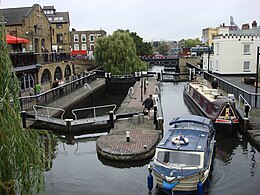Hampstead Road Locks

The twin locks
|
|
| Waterway | Regent's Canal |
|---|---|
| County |
Camden Greater London |
| Maintained by | Canal & River Trust |
| Operation | Manual |
| Fall | 8 feet (2.4 m) |
| Distance to Limehouse Basin |
6.17 miles (9.9 km) |
| Distance to Paddington Basin |
2.77 miles (4.5 km) |
| Coordinates | 51°32′28″N 0°08′45″W / 51.5411°N 0.1457°WCoordinates: 51°32′28″N 0°08′45″W / 51.5411°N 0.1457°W |
Camden Lock is a small part of Camden Town, London Borough of Camden, England, which was formerly a wharf with stables on the Regent's Canal. It is immediately to the north of Hampstead Road Locks, a twin manually operated lock. The twin locks together are "Hampstead Road Lock 1"; each bears a sign so marked. Hawley Lock and Kentish Town Lock are a short distance away to the east, while to the west there is a long level pound, and it is 27 miles (43 km) to the next lock.
Regent's Canal was authorised by an Act of Parliament obtained on 13 July 1812, for a canal from Paddington to Limehouse. When the directors first met, they had decided that all locks would be paired, so that some of the water from a lock emptying could be used to fill the adjacent chamber. Water saving was an important factor, as they knew that water supply would be problematic. Colonel William Congreve, a military engineer who was later knighted, proposed the use of hydropneumatic boat lifts instead of locks. Various designs of a similar nature had been tried in the early nineteenth century, notably at Mells on the Dorset and Somerset Canal and at Tardebigge on the Worcester and Birmingham Canal, but none had proved successful. Congreve's design used two water-filled caissons, which were moved up and down by hand, assisted by compressed air trapped beneath the tanks. With no working examples of such lifts, the directors were understandably cautious, but following an engineer's report, decided that Maudslay & Co should build a prototype at Camden Town. There were a number of technical problems, with the canal company blaming Maudslays for poor design, and Maudslays blaming the canal company for changing the original design and failing to maintain the structure. Congreve's claim that it could be operated in just three minutes was never proved, and in 1818, the directors decided to cut their losses, and reverted to using paired locks. The lift was sold at auction in November 1919, and the 13 lots raised just £404.
...
Wikipedia
